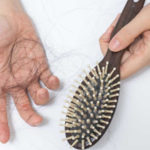The Heavenly Gate point is the seventh point of the Heart Pericardium meridian. According to experts, pressing this point on the wrist can help alleviate many common ailments and symptoms such as chest pain, palpitations, motion sickness, insomnia, and indigestion.
How to locate the Heavenly Gate point
The Heavenly Gate point is located on the wrist, at the intersection of the wrist crease line and the line connecting the middle of the little finger and the ring finger. To locate the point:
Step 1: Place your hand palm up and imagine a straight line from the middle of the little finger to the wrist.
Step 2: Bend your wrist to clearly see the crease line. The point where the straight imaginary line meets the crease line is the location of the Heavenly Gate point.

Location of the Heavenly Gate point
Once you have located the Heavenly Gate point, use your thumb to apply moderate pressure to the point, while the other four fingers provide support under the wrist.
How to stimulate the Heavenly Gate point
Massage the Heavenly Gate point in a clockwise direction for about 2-3 minutes, then switch hands. You can massage the point multiple times, with a 30-second break between each session. The best time to stimulate the Heavenly Gate point is before bedtime.
Health benefits of the Heavenly Gate point
Traditional medicine recognizes the following effects of stimulating the Heavenly Gate point: clearing heart heat, clearing fire, calming the mind, promoting mental clarity, and harmonizing qi. As a result, stimulating this point can be highly effective in treating the following conditions:
1. Regulating cardiovascular function: This includes addressing heart-related conditions such as angina, discomfort, and palpitations.
2. Relieving nervous tension: Stimulating the Heavenly Gate point can help reduce restlessness, anxiety, and uneasiness.
3. Preventing motion sickness: People with weak digestion are prone to motion sickness due to difficulties in digesting food. Stimulating the Heavenly Gate point can help stabilize the blood flow in the stomach, relieving motion sickness symptoms.
4. Improving sleep quality: Restlessness is a common cause of difficulty falling asleep, insomnia, and shallow sleep. Stimulating the Heavenly Gate point before sleep can help you relax and achieve better sleep.
5. Promoting digestion and relieving constipation: The Heavenly Gate point is the origin of the cardiac meridian, and according to the Five Element Theory, the heart belongs to fire, while the spleen and stomach belong to earth, and fire engenders earth. By pressing the Heavenly Gate point, blood supply to the liver and stomach is improved, promoting digestion and relieving constipation.
6. Relieving chest congestion: Stimulation of the Heavenly Gate point helps to enhance blood circulation, thereby improving chest congestion.
7. Alleviating symptoms during menopause: Common symptoms during menopause, such as rapid heartbeat, insomnia, palpitations, sweaty palms, chest pain, and nervous exhaustion, can be improved by stimulating the Heavenly Gate point.
8. Preventing age-related cognitive decline: Stimulating the Heavenly Gate point more often after the age of 50 can help prevent age-related cognitive decline. By ensuring sufficient energy supply to the heart, the likelihood of developing Alzheimer’s disease can be reduced.
9. Managing gastroesophageal reflux disease (GERD): Excessive stress can stimulate the sympathetic nervous system, leading to increased stomach acid secretion and GERD. Stimulating the Heavenly Gate point can help balance the autonomic nervous system, relieve emotional stress, and resolve issues related to GERD.
10. Balancing the autonomic nervous system: The Heavenly Gate point has the function of calming the nerves and regulating the autonomic nervous system. Apply pressure to this point for 10 seconds, rest for 5 seconds, and repeat the process for about 5 minutes on each hand. Stimulate the Heavenly Gate point once a day, preferably in the morning, afternoon, and evening.
Tips for Reducing Risk of Severe Covid-19 Symptoms in People Infected With the SARS-CoV-2 Virus
As the SARS-CoV-2 virus continues to mutate, individuals infected with the virus are now facing an array of different symptoms. From fever to body aches to difficulty breathing, managing the symptoms of the virus is now more important than ever. Doctors are playing a vital role in ensuring patients receive the appropriate treatment for their symptoms, but it is also important for patients to learn how to effectively manage their own symptoms. Read on to find out more.



































